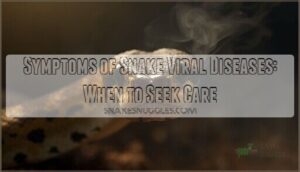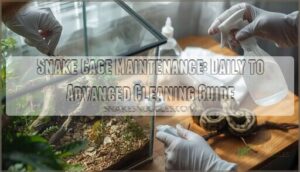This site is supported by our readers. We may earn a commission, at no cost to you, if you purchase through links.

Viral diseases in captive snakes don’t announce themselves with dramatic symptoms at first. They creep in through barely noticeable behavioral shifts, minor feeding hesitations, or slight changes in breathing patterns that owners often dismiss as stress or environmental factors.
Recognizing these early warnings—before star-gazing appears or paralysis sets in—separates successful intervention from devastating collection losses.
Table Of Contents
- Key Takeaways
- Common Snake Viral Diseases
- Respiratory Symptoms of Viral Diseases
- Neurological and Behavioral Signs
- Digestive and Systemic Manifestations
- When to Seek Veterinary Care
- Frequently Asked Questions (FAQs)
- What happens if a snake gets a virus?
- What diseases does a pet snake have?
- What are common snake conditions?
- How do you know if a snake is sick?
- Do snakes have health problems?
- How do you know if you have a snake skin infection?
- Can viral infections spread between different snake species?
- How long can viruses survive outside snake hosts?
- Are there vaccines available for snake viral diseases?
- Can humans transmit viruses to their pet snakes?
- Conclusion
Key Takeaways
- Viral diseases in snakes—including nidovirus, Inclusion Body Disease (IBD), adenovirus, and herpesvirus—often start with subtle symptoms like slight breathing changes, minor feeding hesitations, or behavioral shifts that owners frequently dismiss before severe complications like neurological damage or respiratory failure develop.
- Nidovirus causes respiratory distress with thick mucus and labored breathing, killing 75% of affected snakes in some collections, while IBD produces devastating neurological symptoms like star-gazing and tremors with a 100% mortality rate once symptoms appear.
- Early warning signs requiring immediate veterinary attention include labored breathing, excess mucus, regurgitation, weight loss exceeding 10%, lethargy, poor coordination, muscle tremors, and abnormal head positioning—with PCR testing detecting infections weeks before clinical signs emerge and improving survival rates by up to 60%.
- No vaccines exist for snake viral diseases, so prevention depends on strict quarantine protocols, proper hygiene, and rapid veterinary diagnosis using specialized PCR testing, since viruses like adenovirus can survive on surfaces for weeks to months and spread easily between species in captivity.
Common Snake Viral Diseases
Your snake’s health depends on recognizing viral threats before they become critical.
Three major viral diseases strike pet snakes with alarming regularity, each presenting distinct challenges for diagnosis and management.
Let’s examine the specific infections you need to watch for.
Nidovirus Infection
Nidovirus strains have emerged as one of the most concerning viral threats in captive snake collections, particularly among pythons. If your snake shows labored breathing, open-mouth gasping, or thick mucus around the nose and mouth, you’re witnessing classic nidovirus symptoms in snakes.
These reptile nidovirus infections spread through respiratory droplets and contaminated surfaces, making transmission routes difficult to control. What makes diagnostic challenges so frustrating is that chronic carriers can appear healthy for months while silently spreading disease.
The virus targets lung pathology specifically, causing severe tissue damage that’s often irreversible by the time symptoms appear. Early detection is improved with regular veterinary check-ups.
Inclusion Body Disease (IBD)
While nidovirus attacks the respiratory system, Inclusion Body Disease (IBD) takes a different and more devastating path. This neurological condition in snakes—caused by Reptarenavirus—shows up in about 27% of captive boas and 5% of pythons. Symptoms of snake viral diseases like IBD include the telltale “star-gazing” posture, loss of coordination, and regurgitation. IBD is a fatal viral disease with no known cure.
You’ll notice:
- Head corkscrewing or abnormal positioning
- Tremors and facial tics in 65% of late cases
- Rapid weight loss exceeding 15% of body mass
- Seizures and loss of righting reflex
- Appetite loss followed by neurological decline
IBD diagnosis requires histopathology showing characteristic inclusion bodies in liver and kidney tissue. The IBD prognosis is grim—once neurological IBD symptoms appear, mortality reaches 100% within a year. Boas can carry the virus for years before showing signs, silently spreading Reptarenavirus causation throughout collections.
Adenovirus and Herpesvirus Infections
Beyond IBD, two other viral threats demand your attention: adenovirus and herpesvirus infections. Adenovirus spreads through fecal-oral transmission and causes hepatic necrosis in up to 26% of captive snakes. You’ll see species susceptibility differences—boas develop chronic disease while pythons often die within weeks.
Herpesvirus produces respiratory signs and stomatitis, and can reduce venom production by half. Both require strict quarantine protocols and show overlapping viral symptoms, making early veterinary diagnosis critical for your snake’s survival.
Respiratory Symptoms of Viral Diseases
When a snake struggles to breathe, something’s wrong—and with viral infections, respiratory symptoms often show up first. These signs can range from subtle changes in breathing patterns to obvious distress that demands immediate attention.
Here’s what to watch for in your snake’s respiratory system.
Labored or Open-Mouth Breathing
When your snake struggles to breathe or keeps its mouth open, you’re witnessing respiratory distress that demands immediate attention. This symptom appears in 59% of nidovirus-infected pythons and signals serious viral infections like nidovirus or viral pneumonia.
Airway obstruction from mucus buildup can rapidly escalate, driving mortality rates to 75% in some collections. These respiratory problems often lead to euthanasia decisions when respiratory signs become severe, so don’t wait—contact your reptile vet at the first sign of labored breathing.
Excess Mucus in Mouth or Nostrils
Clear or cloudy fluid pooling around your snake’s mouth and nostrils is a hallmark of respiratory disease, appearing in nearly 100% of early serpentovirus cases. This mucus often starts thin but can thicken into stubborn coatings, creating respiratory distress and airway obstruction.
Chronic mucus production persists throughout the disease course, frequently accompanied by co-infection factors like bacteria that complicate recovery.
Diagnostic swabbing of these secretions detects viral infections with over 90% accuracy, making early recognition critical for your snake’s survival.
Swelling of Throat or Upper Airways
When visible swelling develops in your snake’s throat or neck region, you’re witnessing airway obstruction that demands immediate action.
In nidovirus-infected pythons, 59% show clinical respiratory disease with prominent pharyngeal edema, while herpesvirus causes neck swelling in up to 50% of outbreaks.
This edema severity signals viral infections progressing toward respiratory problems, often accompanied by audible breathing and secondary infections that worsen the prognostic indicators through histopathology findings of tissue inflammation.
Neurological and Behavioral Signs
When a virus attacks your snake’s nervous system, the symptoms can look unsettling and progress quickly. Neurological signs often appear suddenly and demand immediate veterinary attention.
Here are three critical behavioral changes that signal your snake needs emergency care.
Star-Gazing Behavior
When your snake lifts its head skyward and holds it there—think of it like someone staring at the ceiling for no reason—you’re witnessing star-gazing behavior, one of the most alarming neurological symptoms tied to viral infections. This clinical presentation stems from central nervous system dysfunction, particularly damage to the brainstem caused by viral etiologies like Inclusion Body Disease.
Over 60% of snakes displaying this behavior test positive for reptarenavirus. Environmental triggers can mimic these neurological conditions in snakes, but true viral star-gazing rarely resolves—mortality exceeds 85% once sustained disorientation appears.
Poor Coordination and Ataxia
When your snake moves like it’s walking through thick fog—unsteady, off-balance, unable to coordinate its body—you’re observing viral ataxia, a devastating neurological impact of diseases like IBD. Studies document neurological symptoms in up to 87% of reptarenavirus-positive snakes, with poor coordination often appearing before other obvious snake symptoms.
This diagnostic challenge complicates early detection because viral infections in snakes frequently produce subclinical carriers who spread disease before showing neurological conditions in snakes themselves.
Disease progression accelerates rapidly once ataxia emerges, particularly in juvenile boas, making effective management strategies nearly impossible—no treatment reverses these neurological issues.
Muscle Tremors and Paralysis
If you’ve ever witnessed your snake’s muscles rippling in involuntary waves, you’re seeing tremor severity that demands immediate action. Once muscle tremors emerge—documented in over 35% of tested boas with Established IBD—paralysis progression usually follows within days to months, making these among the most critical Diagnostic Indicators:
- Tremors often precede ascending paralysis, starting at the tail and moving forward
- Snakes with both tremors and paralysis face mortality rates exceeding 90%
- Viral load correlates directly with tremor intensity and Neurological conditions in snakes
- Complete posterior paralysis eliminates normal locomotion in advanced stages
These Prognostic Factors point to devastating outcomes for Inclusion Body Disease and other viral infections, with pythons showing neurological issues progressing faster than boas.
Digestive and Systemic Manifestations
Viral infections don’t just attack your snake’s respiratory or nervous system—they can wreak havoc on digestion and overall energy levels too. When a virus spreads through your snake’s body, you’ll often notice changes in eating habits, activity, and physical condition.
Here’s what digestive and systemic symptoms look like in snakes fighting viral disease.
Regurgitation After Eating
When your snake brings up a meal within days of eating, you’re witnessing viral regurgitation—a red flag for snake viral infections. Inclusion Body Disease causes this in 70% of infected boas, while nidovirus disrupts digestion through mucosal damage in ball pythons.
Species susceptibility varies: boas dominate IBD cases, pythons show nidovirus symptoms.
Diagnostic trends reveal that regurgitation precedes neurological decline in 68% of viral disease cases, making early recognition important.
Lethargy and Decreased Activity
You might miss lethargy until disease progression accelerates—infected snakes reduce activity by 40–85% before you notice. In nidovirus cases, 70% show lethargy as their first symptom, appearing 2–12 days before respiratory distress.
Quantifying lethargy through decreased movement helps with early detection: boas with IBD lose 65% of baseline activity within weeks.
Activity reduction signals viral impact on snake health, making observation critical for catching viral infections early.
Weight Loss and Appetite Changes
When lethargy persists, weight decline often follows. Up to 65% of snakes with viral diseases display clear feeding refusal, with nidovirus-infected snakes losing 8–15% body mass within a month. IBD causes even steeper drops—10–22% over 2–8 months—as viral anorexia sets in.
You’ll notice appetite changes before other symptoms worsen: snakes refusing meals for four weeks face median survival under eight months. Weight loss exceeding 10% signals you need veterinary testing immediately.
When to Seek Veterinary Care
Knowing when your snake needs professional attention can mean the difference between early intervention and a life-threatening situation. Certain symptoms warrant immediate veterinary care, while others require monitoring and scheduled evaluation.
Here’s what you need to watch for and why timing matters when dealing with potential viral infections.
Early Warning Signs to Watch For
When should you schedule a vet visit for your snake? Subtle behavior changes, like decreased activity, appear in up to 80% of virus-infected snakes during the first month. Early detection through veterinary presentation saves lives.
Watch for initial respiratory signs—labored breathing, excess mucus—which affect 60% of nidovirus cases within two weeks. Early digestive issues, like loss of appetite, occur in 68% of infected snakes, while neurological indicators such as abnormal posture emerge in 41% of cases. Don’t wait for symptoms to worsen.
Importance of Timely Diagnosis
Quick diagnostic testing changes the outcome. PCR-based methods detect snake viral disease diagnosis with over 95% sensitivity, confirming nidovirus or IBD weeks before clinical signs appear.
Early detection through diagnostic technologies improves prognosis by up to 60% and cuts mortality in half. That’s why timely viral diagnosis matters—it facilitates containment impact, delivers economic benefits, and advances therapeutic options.
Don’t wait until symptoms worsen to act.
Role of Reptile Veterinarians
Reptile veterinarians bring specialized veterinary training and diagnostic tools to cases that most general vets won’t touch. Their reptile expertise makes all the difference when symptoms could mean nidovirus, IBD, or another viral threat. They provide:
- Sophisticated PCR testing and immunohistochemistry for accurate diagnosis
- Species-specific treatment protocols targeting secondary infections
- Quarantine guidance protecting your collection from disease spread
- Ongoing medical research participation improving snake diseases outcomes
Veterinary care from a reptile specialist gives your snake the best chance at survival and bolsters broader conservation efforts through surveillance data.
Frequently Asked Questions (FAQs)
What happens if a snake gets a virus?
When a snake contracts a virus, symptoms can range from mild respiratory issues to severe neurological damage. Viral infections often trigger a weakened immune response, allowing rapid viral shedding and virus transmission within collections.
Without proper diagnosis and quarantine, these snake diseases progress quickly—sometimes fatally within weeks.
What diseases does a pet snake have?
Regarding keeping your scaled friend healthy, don’t let viral infections snake their way into your pet’s life. Your snake can develop respiratory disease from nidovirus or paramyxovirus, causing breathing difficulties and excess mucus.
Inclusion Body Disease remains one of the most serious viral infections affecting snake health and care, often showing neurological symptoms.
Disease prevention through proper reptile care and veterinary guidance helps protect against adenovirus, herpesvirus, and other threats.
What are common snake conditions?
Beyond viral infections, your snake faces several common health challenges. Bacterial stomatitis, skin infections from poor husbandry, intestinal parasites, and respiratory diseases from fungi or bacteria frequently affect captive snakes, each requiring specific veterinary diagnostic tools and targeted snake infection control measures.
How do you know if a snake is sick?
Sick snake identification starts with spotting the subtle shifts your pet doesn’t want you to see. When snake behavior changes—refusing food, hiding more than usual, or moving less—viral load testing and health check protocols become critical.
Signs of snake diseases include labored breathing, excess mucus, poor coordination, regurgitation, or unusual posturing, all flagging potential viral infection requiring immediate snake disease diagnosis.
Do snakes have health problems?
Yes, snakes face numerous Snake Health Issues ranging from Viral Disease Transmission and Parasite Infections to respiratory disease and metabolic disorders. Their Snake Immune Systems can struggle against viral threats, making Reptile Veterinary Care essential for snake disease diagnosis and prevention.
How do you know if you have a snake skin infection?
Watch for visible changes like skin lesions, discoloration, ulcers, or abnormal shedding that signal bacterial dermatitis or fungal infections. You’ll also notice behavioral shifts—your snake may rub against surfaces excessively, hide more frequently, or show lethargy, especially when environmental factors like poor hygiene or high humidity create conditions for skin parasites and dermatitis to develop.
Can viral infections spread between different snake species?
Regarding viral transmission, snakes aren’t playing a solo game—these pathogens can jump between species like unwelcome guests at a crowded party.
Nidovirus, Inclusion Body Disease, and adenovirus infections readily cross species barriers, especially in captive collections where mixed populations share space, creating perfect conditions for interspecies risk and viral mutation.
How long can viruses survive outside snake hosts?
Understanding viral persistence outside your snake’s body is critical for preventing disease spread in your collection. Different viruses show dramatically different survival times on surfaces. Adenoviruses are the toughest, persisting for weeks or even months in the environment. Nidoviruses can remain detectable for over a year under certain conditions, though their actual infectivity drops much faster.
Temperature and humidity both play major roles in viral survival—cooler, more humid conditions extend persistence markedly. In contrast, IBD virus and herpesviruses break down within days to weeks outside the host. Surface type matters too. Nonporous materials like plastic and stainless steel support longer viral survival than porous materials like wood or fabric.
Cooler, humid conditions extend viral survival on surfaces, with nonporous materials like plastic harboring infectious particles far longer than porous ones like wood
This means your feeding tongs, water bowls, and enclosure furnishings can harbor infectious particles longer than you’d expect. UV light and proper disinfectants dramatically reduce viral persistence, which is why rigorous sanitation protocols are non-negotiable in any collection. Environmental factors heavily influence viral transmission risk, making consistent disinfection your first line of defense against disease spread.
Are there vaccines available for snake viral diseases?
Unfortunately, no commercial vaccines exist for snake viral infections like Inclusion Body Disease or nidovirus. Research into vaccine development continues, but immunological barriers in reptiles and rapid viral mutation make this challenging. Your best defense remains strict quarantine protocols and preventative measures.
Can humans transmit viruses to their pet snakes?
Yes, reverse zoonosis occurs when humans transmit viruses to snakes through close contact, contaminated environments, or poor handler hygiene.
Coronaviruses and respiratory viruses pose zoonotic risks due to viral mutation enabling cross-species transmission via human-snake interaction and shared zoonotic pathways.
Conclusion
That wheeze you caught during feeding? It’s your earliest advantage in fighting viral disease. Recognizing symptoms of snake viral diseases before they escalate—whether it’s subtle mucus buildup, behavioral changes, or the first signs of respiratory distress—gives you the window to act.
Don’t second-guess respiratory changes or neurological symptoms. Contact a reptile veterinarian immediately when you notice anything unusual, because delayed diagnosis turns manageable infections into fatal outcomes.
- https://www.frontiersin.org/journals/veterinary-science/articles/10.3389/fvets.2021.733404/full
- https://coloradoexoticanimalhospital.com/reptiles-amphibians/serpentovirus-nidovirus-snakes
- https://pmc.ncbi.nlm.nih.gov/articles/PMC7459564/
- https://www.merckvetmanual.com/exotic-and-laboratory-animals/reptiles/viral-diseases-of-reptiles
- https://www.sciencedirect.com/science/article/pii/S1055937X99800413












